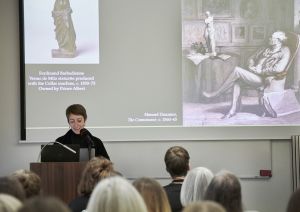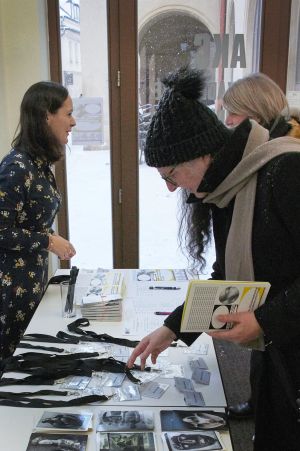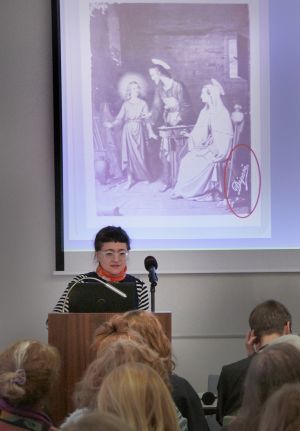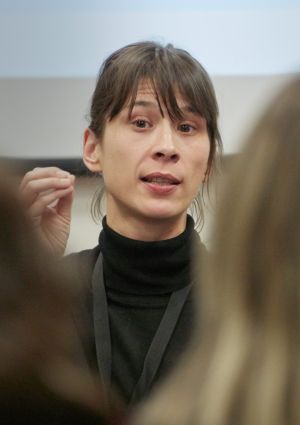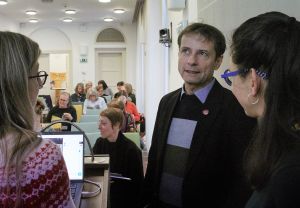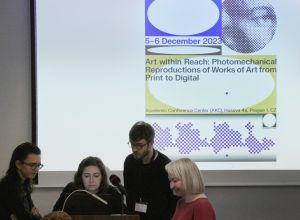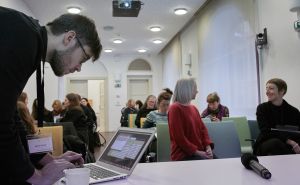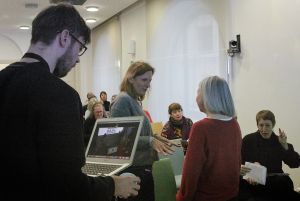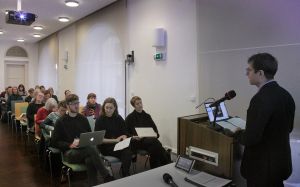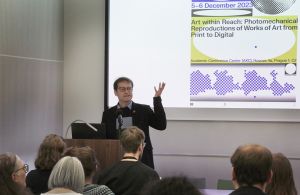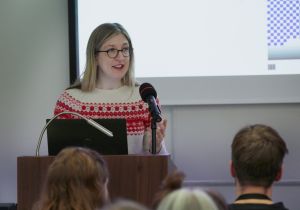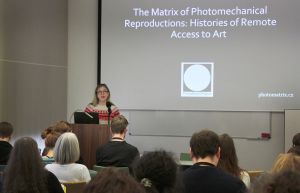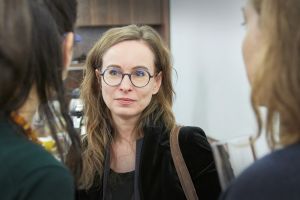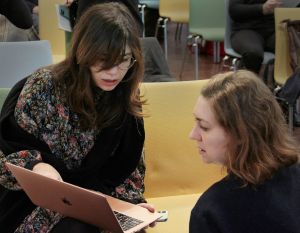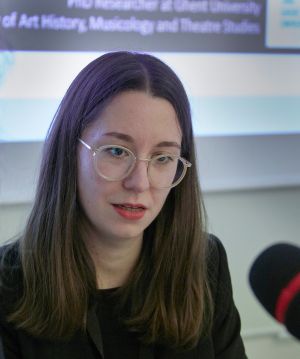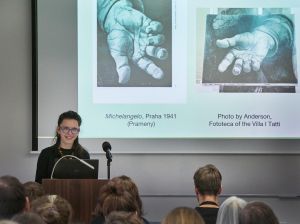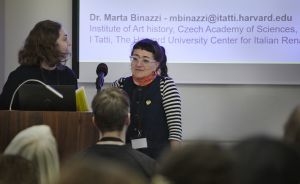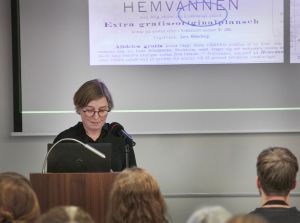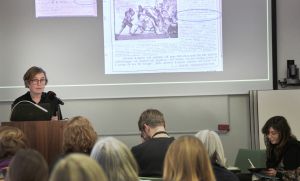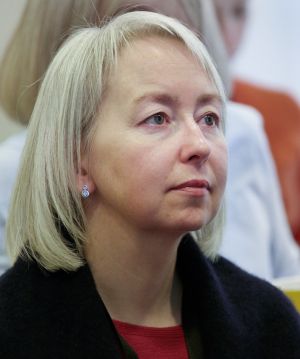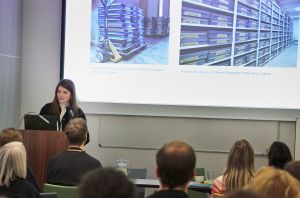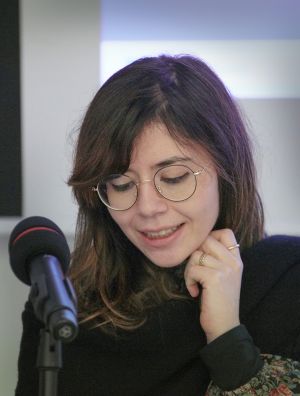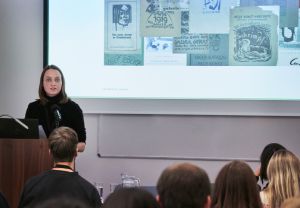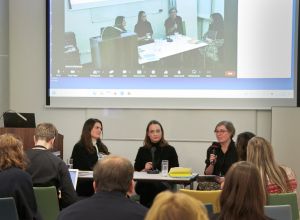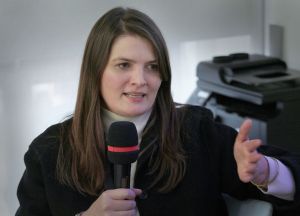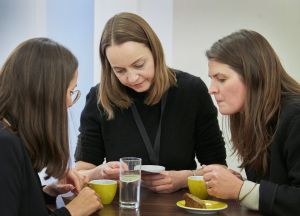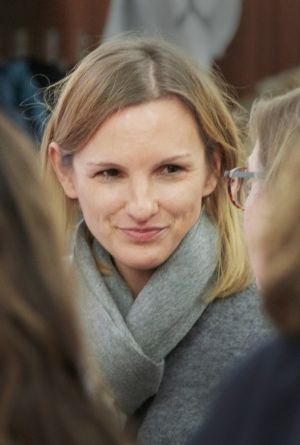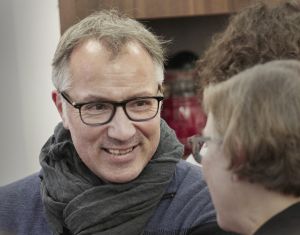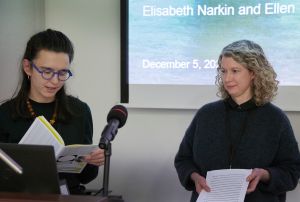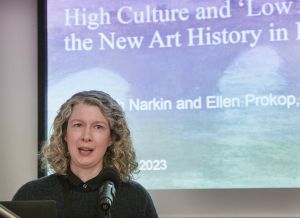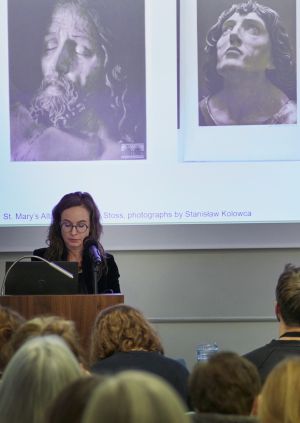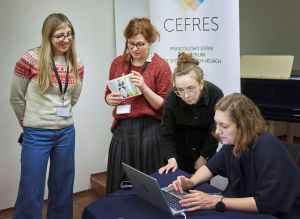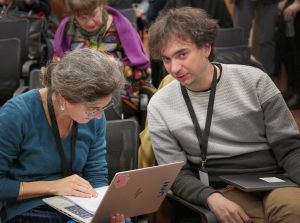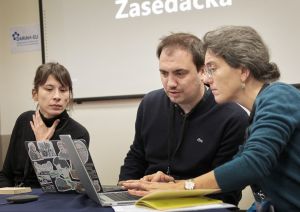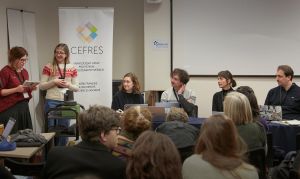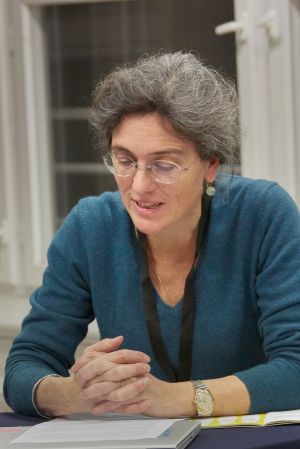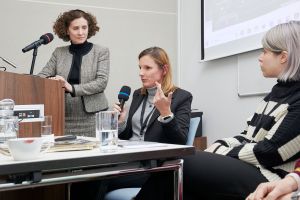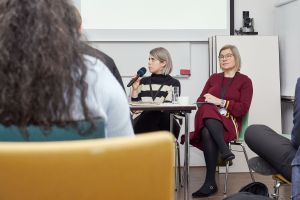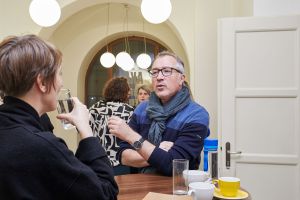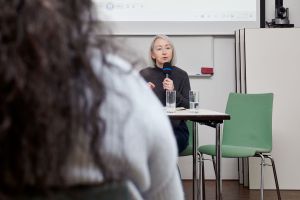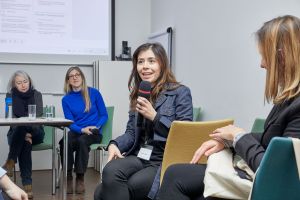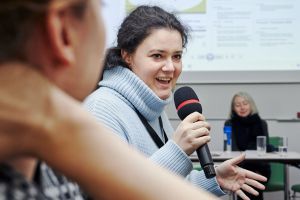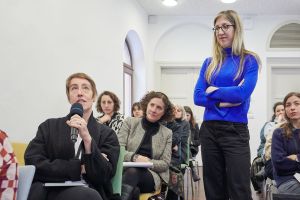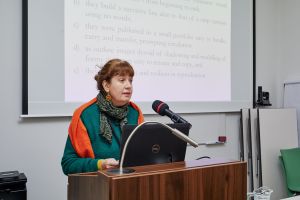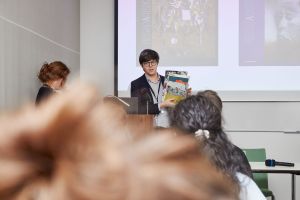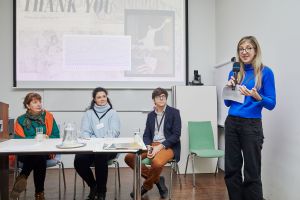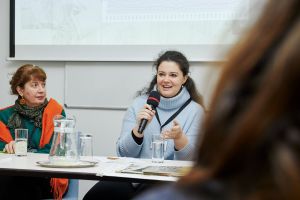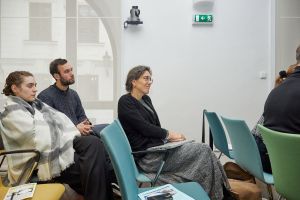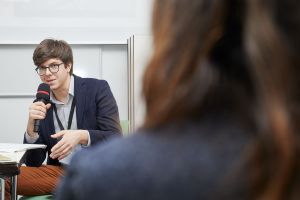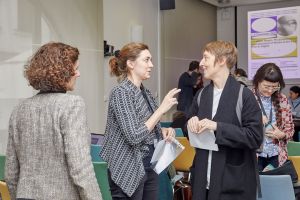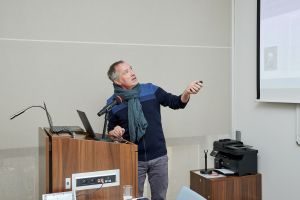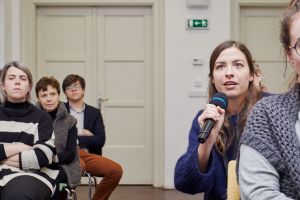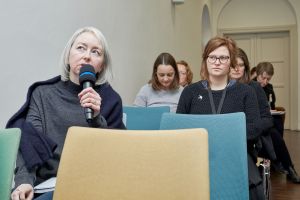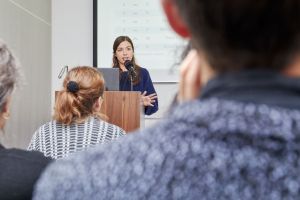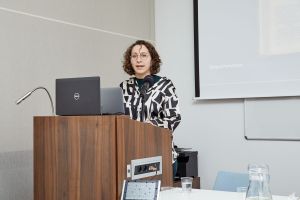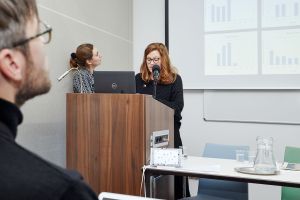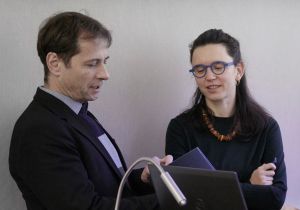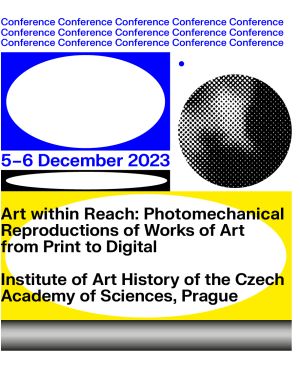
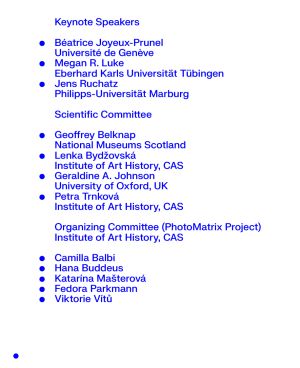
Program
9:00
Registration
9:30
Introductions
→ Tomáš Winter, the director of the Institute of Art History, Czech Academy of Sciences
→ organizing committee
10:00–11:00
KEYNOTE LECTURE 1
→ Megan R. Luke (Eberhard Karls Universität Tübingen)
Sculpture’s Artificial Intelligence
11:00–11:15
Coffee break
11:15–12:30
PANEL 1: Behind the Production of Images
Chair: Katarína Mašterová (Institute of Art History, Czech Academy of Sciences)
→ Griet Bonne (Ghent University)
Rubens’ Oeuvre “d’après les estampes”: Hybrid Images in the Transformation of the Late-Nineteenth-Century Illustrated Art Book
→ Hana Buddeus (Institute of Art History, Czech Academy of Sciences)
The Production of Photomechanical Reproductions of Art: Consensual Exchange, Stolen Glances and Embellished Reality
→ Marta Binazzi (Institute of Art History, Czech Academy of Sciences)
Behind the Photographs: Copyright and Photomechanical Reproductions of Art, a Burning Issue in Europe at the Turn of the 20th Century
12:30–13:30
Lunch break
13:30–14:45
PANEL 2: Art Markets
Chair: Camilla Balbi (Institute of Art History, Czech Academy of Sciences)
→ Anna Näslund (Stockholm University)
Pictorial Commodities
→ Franziska Lampe (Bildarchiv Bruckmann, Zentralinstitut für Kunstgeschichte, Munich)
The Afterlife of Photo Campaigns: On the Sustainable Use of Reproductions
→ Julia Bärnighausen (Berlinische Galerie - Museum of Modern Art, Photography and Architecture)
Selling Art through Images: Photomechanical Reproductions in German Gallery Publications (1912–1949)
14:45–15:00
Coffee break
15:00–16:15
PANEL 3: Art Historical Narratives
Chair: Hana Buddeus (Institute of Art History, Czech Academy of Sciences)
→ Elisabeth Narkin and Ellen Prokop (National Gallery of Art, Washington D.C.)
High Culture and “Low Art”: Reproductive Prints and the New Art History in Late Nineteenth-Century Paris
→ Camilla Balbi (Institute of Art History, Czech Academy of Sciences)
Rachel Wischnitzer and the Photomechanical Foundations of Jewish Art History
→ Dorota Łuczak (Adam Mickiewicz University in Poznań)
The Role of the Reproductions of Wit Stwosz's St. Mary's Altarpiece in Building the Cultural and Social Status of the Work of Art after 1945
16:15–17:00
Walking or public transport to CEFRES (Na Florenci 3, Prague 1)
17:00–18:30
ROUNDTABLE ON DIGITAL ART HISTORY in CEFRES (Na Florenci 3, Prague 1)
Introductions:
→ Mateusz Chmurski (the director of CEFRES)
→ Viktorie Vítů (Institute of Art History, Czech Academy of Sciences)
Moderator:
→ Béatrice Joyeux-Prunel (Université de Genève)
Panelists:
→ Sanja Sekelj (Institute of Art History, Zagreb)
→ Thomas Smits (University of Antwerp)
→ Lukáš Pilka (Institute of Art History, Czech Academy of Sciences)
18:30–19:00
Glass of wine at CEFRES
19:30
Dinner for the speakers and guests of the conference
9:30–10:30
KEYNOTE LECTURE 2
→ Béatrice Joyeux-Prunel (Université de Genève)
Exploring Visual Culture in the Mechanical Age: Bridging Dreams, Methods, and Realities
10:30–10:45
Coffee break
10:45–12:00
PANEL 4: Artistic Circulations
Chair: Fedora Parkmann (Institute of Art History, Czech Academy of Sciences)
→ Evanghelia Stead (Université de Versailles-Saint-Quentin)
Goethe's Faust I from Outline Etchings to Photomechanical and Digital Reproductions in European and World Circulation
→ Wiktor Komorowski (Courtauld Institute of Art, London)
The Soviet Plato’s Cave: Przegląd Artystyczny and Sztuka as the Windows onto the World
→ Marie Barras (Université de Genève)
Fashion Discourses at the Turn of the 20th Century: Unraveling Paris’s and New York’s Perceptions through the Distant Reading of Texts and Images in Magazines
12:00–13:00
Lunch break
13:00–14:00
KEYNOTE LECTURE 3
→ Jens Ruchatz (Philipps-Universität Marburg)
Plates and Illustrations. Historical Observations on Image-Word Relations in Photographic Art Reproductions
14:00–14:15
Coffee break
14:15–15:30
PANEL 5: Dissemination, Popularization
Chair: Lenka Bydžovská (Institute of Art History, Czech Academy of Sciences)
→ Mirja Beck (Weissensee Kunsthochschule Berlin)
Presenting the Popular – Popularization of Art Reproductions in (Para)Texts around 1900
→ Morgane Ott (Université de Liège)
Reproducing Artworks in the Context of Belgian Photojournalism and Mass-Market Print Culture during the Interbellum: The Case of Germaine Van Parys (1893-1983) through the Artpresse Corpus
→ Katarína Mašterová and Viktorie Vítů (Institute of Art History, Czech Academy of Sciences)
Artists as Influencers? Emil Filla and Josef Wagner, Prominent Figures of Czech Modernism, as Editors of the Art Magazine Volné Směry
15:30–15:45
Coffee break
15:45–17:00
PANEL 6: Politics and Identity Building
Chair: Geraldine A. Johnson (University of Oxford, UK)
→ Nina Lager Vestberg (Norwegian University of Science and Technology)
A Nation in Its Own Images: Art Reproduction in Early 20th-century Norway
→ Viviana Costagliola (Biblioteca Hertziana, Rome)
“Nothing Will Remain But Photographs”: Photomechanical Reproductions of the Italian South's Heritage in Napoli Nobilissima Magazine (1892–1907)
→ Marta Ziętkiewicz (Institute of Fine Art, Polish Academy of Sciences)
“Heaven’s Gates”: Politics of Photomechanically Illustrated Publications Documenting Jewish Monuments in Poland (1903–1957)
17:00–17:15
Coffee break
17:15–18:00
Closing Remarks by Petra Trnková (Institute of Art History, Czech Academy of Sciences) & Closing Discussion
Optional excursion
10:00–12:00 National Technical Museum, Department of Polygraphy, with the curator Pavel Pohlreich
Address: Kostelní 1320/42, 170 00 Praha 7
Free of charge, advance registration required: masterova[at]udu.cas.cz
About
With the development of photomechanical printing techniques around 1900, the dissemination of visual information about art objects expanded on an unprecedented scale. For the first time, editors, publishers, gallerists, auctioneers, artists, art historians, and associations had access to a seemingly unlimited supply of images. Together with photographers, studios, and photo agencies, these figures became key actors in a distribution model in which photomechanically reproduced artworks played a central role. As a consequence, those who worked in the fields of art and art history now had to deal with entirely new visual objects: from illustrated books and periodicals to facsimiles, postcards, calendar pages, and clipping collections. All these items were kept on shelves and in boxes, included in scrapbooks, or pinned to walls, as part of personal or institutional archives. They served both as research documents and as evidence of personal visual obsessions or new collective ideas.
The diversity of these novel photomechanical sources, the system that produced and surrounded them, and their distribution and cultural impact are still an open field for investigation, one that seems all the more important to address as this visual information – made widely accessible by the digitization campaigns of recent years – can form the basis for material and medial counter-history of twentieth-century art. In order to reflect on the specific nature of photomechanical reproductions of art (with regard to their materiality, distribution, and uses), the conference navigates between the fields of the history of art and photography, periodical studies, visual and media studies, and the digital humanities.
Which actors and techniques were involved in making photomechanical reproductions of works of art? What were the socio-economic and aesthetic drivers of the activities of photo agencies and publishers? Which subjects whose identity has so far remained in the background – such as women or minorities – can be reclaimed by analyzing reproductions from a material and systemic perspective? What role did pictures of works of art play in the editorial and cultural policies of their time? What do we know about their reception? How did the photomechanical reproduction of artworks affect art historiography, teaching, criticism, and the canon? Which narratives that have fallen out of the canon can be restored through digital methods?
These questions take on a new urgency with the increasing importance of the digital processing of image data, as it has opened new horizons for studying reproductions on a large scale, removed some of the limitations of accessibility, and paved the way for larger comparative studies. At the same time, these new tools raise critical questions that have not been fully explored, and require greater awareness of the objects, techniques, processes, and contexts under consideration. We invited speakers from across the methodology spectrum: from close to distant reading, from traditional to digital-based approaches. The goal is to open a discussion between scholars conducting qualitative research and the growing number of digital experts working in interdisciplinary teams.
Abstracts
Keynote lecture 1
Megan R. Luke
Sculpture’s Artificial Intelligence
Tuesday 5 December 2023, 10:00–11:00
Sculpture’s Artificial Intelligence
What can the history of the industrial fabrication of sculpture teach us about the materiality and format of photomechanical reproductions? Whereas each copy in a limited edition of a particular sculpture could lay claim to the “originality” of the model executed by the artist’s hand, a commercial series of reductions licensed and produced by fine art foundries and metalware manufactories in the late nineteenth and early twentieth centuries appeared increasingly autonomous from any unique creation. With the introduction of mechanical reduction machines, the application of copyright law to works of art, and the invention of new technologies for the automatic replication of images and objects came a fundamental shift in the relationships between art and industry, sculpture and its surrogates. This talk will focus on two technologies that redefined these relationships in the century after their near-simultaneous announcement to the international scientific community in the late 1830s: electrotyping and photography. Not only could sculptural objects be cast in metal using electricity rather than fire, but this same technology could be used to fabricate the plates for the mechanical reproduction of photographs on a mass scale. Likewise, photography was not only an instrument that could convincingly reproduce sculptures as planar images, but it also aided the creation of three-dimensional facsimiles in combination with other technical apparatuses. From the very start, photography and electrotyping were linked in the public imagination, and these technologies, in turn, seemed to participate in the “mechanization of intelligence” with which we remain engaged today. Yet when they were applied to sculpture, the historical function of this art to serve as a tangible link to the past appeared increasingly at risk.
Megan R. Luke is Professor of Modern and Contemporary Art History at the Universität Tübingen. She is the author of Kurt Schwitters: Space, Image, Exile (Chicago, 2014), co-editor of Photography and Sculpture: The Art Object in Reproduction (Getty, 2017), and editor of the English-language edition of Schwitters’s collected theoretical writings, Myself and My Aims: Writings on Art and Criticism (Chicago, 2021). She is currently completing her next monograph, Sculpture in an Age of Mass Reproduction: Untimely Objects in German Art and Media Theory.
Keynote lecture 2
Béatrice Joyeux-Prunel
Exploring Visual Culture in the Mechanical Age: Bridging Dreams, Methods, and Realities
Wednesday 6 December 2023, 9:30–10:30
Exploring Visual Culture in the Mechanical Age: Bridging Dreams, Methods, and Realities
This presentation aims to address the challenge posed by the global study of printed visual cultures in the era of mechanical reproducibility. It is tempting to view digital reproducibility as the perfect solution for global visual studies. It not only allows for the globalization of corpora through digitization but also offers computational approaches to decipher the underlying patterns in the vast flood of images, their channels, thresholds, and circulation rates. However, this approach tends to downplay the significant problems it raises, from the difficulty of assembling representative corpora to dealing with the cultural complexities that underlie the circulation of printed images. While demonstrating the potential advantages of a computational approach in analyzing the global circulation of illustrated prints (in particular the Visual Contagions project), this keynote address will also emphasize the importance of adopting complementary scales and methods that extend beyond the limitations of "cultural analytics." Furthermore, by seriously examining the convergence of these three modes of mechanical reproducibility in research—namely, the historical printed, the archival digital, and the methodological computational—this presentation will explore how this convergence can foster a form of productive self-reflection. Taking inspiration from Walter Benjamin's ideas, this presentation will critically examine the transformation of the aura of images within research, as well as the aura surrounding the research process itself.
Béatrice Joyeux-Prunel is a Full Professor at the University of Geneva, Switzerland, where she chairs the Digital Humanities. From 2007 to 2019 she was Associate Professor of modern and contemporary art at the École normale supérieure, Paris, France. Her research interests include the global history of the avant-gardes, visual globalization, the visual culture of petroleum, crypto-art, and the NFTs. Among other research projects, she has directed the international project Artl@s since 2009, whose global database of exhibition catalogues BasArt contributes to a more global and social art history. She also directs the Visual Contagions project (2021–2025), which focuses on the global circulation of images and whose Explore database enables the tracking of image circulation in 19th and 20th-century printed media. She is the author of an acclaimed trilogy on the social and global history of avant-gardes (1848–1918, 1918–1945, 1945–1970 – in French, with an English translation currently in progress). Since 2006, Béatrice Joyeux-Prunel has been organizing seminars focusing on global and computational approaches to art history. In the 2023-2024 online edition, she is co-organizing the Artl@s Seminar with Catherine Dossin from Purdue University and Nicola Carboni from the University of Geneva. The seminar aims to explore the question: "Do We Need Digital Art History?"
Keynote lecture 3
Jens Ruchatz
Plates and Illustrations. Historical Observations on Image-Word Relations in Photographic Art Reproductions
Wednesday 6 December 2023, 13:00–14:00
Plates and Illustrations. Historical Observations on Image-Word Relations in Photographic Art Reproductions
The introduction of photomechanical reproduction has affected not only the availability and sheer number of art reproductions, but also their modes of presentation in print culture. As a technology of reproduction, photography has turned images into malleable design elements that can be easily inserted into diverse constellations of words and images. The paper will focus first on the layout strategies associated with the late-19th-century halftone (and its predecessor, the line block) and then on various modes of presenting works of art in 20th-century print publications, primarily popular magazines. Several case studies will be examined to show how artworks figure in features about artists in their studios. These examples are not chosen with the ambition to construct a concise history but rather to provide insights into the diverse visual rhetorics of the layouts employed. The presentation of artworks in the medial constellations of the printed page will be construed as a means of popularizing (and commercializing) as well as elevating art in the 20th century.
Jens Ruchatz is Professor of Media Studies at Philipps-University Marburg. From 2016 to 2023, he acted as deputy speaker of the research unit “journal literature” in which he led the project 5 ‘Fragment migrations’. His research interests include the history and theory of photography, periodical and serial forms in media, culinary media, the history of the interview, and media reflection. Recent publications regarding printed photography: “Bild-Schrift-Konstellationen: Die Multimedialität der Zeitschrift”, in: Oliver Scheiding/Sabina Fazli (Hg.), Handbuch Zeitschriftenforschung. Eine Einführung, Bielefeld: Transcript 2022, pp. 109-130; “The Recipe and Photography. The Sensual Appeal of Image-Word Relations in Cookbooks”, in: Christina Bartz / Jens Ruchatz / Eva Wattolik (eds.): Food – Media – Senses. Interdisciplinary Approaches, Bielefeld: Transcript 2023, pp. 159–194 (Open Access).
Roundtable on Digital Art History
Béatrice Joyeux-Prunel, Sanja Sekelj, Thomas Smits, Lukáš Pilka
Roundtable on Digital Art History
Tuesday 5 December 2023, 17:00–18:30 (at CEFRES)
Roundtable on Digital Art History
In the new and fast-changing landscape of digital art history, a field that transcends traditional boundaries, computational methods are now employed to open up new dimensions of humanistic research. The Digital Art History Roundtable responds to the growing need for convergence among scholars in this pioneering and interdisciplinary field. What approaches to printed pictures are made possible by digital tools? What are the methodological challenges and current results? In what directions do new technologies shift traditional research? At the intersection of art history and technology, the roundtable offers a platform for established and emerging scholars and digitization professionals alike.
Moderator:
Béatrice Joyeux-Prunel is a Full Professor at the University of Geneva, Switzerland, where she chairs the Digital Humanities. From 2007 to 2019 she was Associate Professor of modern and contemporary art at the École normale supérieure, Paris, France. Her research interests include the global history of the avant-gardes, visual globalization, the visual culture of petroleum, crypto-art, and the NFTs. Among other research projects, she has directed the international project Artl@s since 2009, whose global database of exhibition catalogues BasArt contributes to a more global and social art history. She also directs the Visual Contagions project (2021–2025), which focuses on the global circulation of images and whose Explore database enables the tracking of image circulation in 19th and 20th-century printed media. She is the author of an acclaimed trilogy on the social and global history of avant-gardes (1848–1918, 1918–1945, 1945–1970 – in French, with an English translation currently in progress). Since 2006, Béatrice Joyeux-Prunel has been organizing seminars focusing on global and computational approaches to art history. In the 2023-2024 online edition, she is co-organizing the Artl@s Seminar with Catherine Dossin from Purdue University and Nicola Carboni from the University of Geneva. The seminar aims to explore the question: "Do We Need Digital Art History?"
Panelists:
Sanja Sekelj is a postdoctoral researcher at the Institute of Art History in Zagreb. In 2021, she defended her PhD thesis “Digital Art History and Artists’ Networks in Croatia in the 1990s and 2000s” at the University of Zadar. Her research has largely focused on interpreting the cultural dynamics and networking practices of the actors in Croatian visual arts scene at the turn of the millennium (1991–2006). Recently, she has also examined the mechanisms of international cultural exchange in Croatia and Yugoslavia in the 1980s. She was a member of the scientific research project ARTNET (IPU, 2014–2018), a member of the curatorial team of the Miroslav Kraljević Gallery in Zagreb (until 2016), and executive editor of the scientific journal Život umjetnosti (2018–2021). She is currently a team member of the research projects GLOBE Exchange (IPU, 2020–2023) and “New public culture and spaces of sociability” (Clubture, 2022–2023).
Thomas Smits is an Assistant Professor of digital history and AI at the University of Amsterdam. A historian with an interest in visual culture and computer-assisted methodologies, he is the author of the prize-winning The European Illustrated Press and the Emergence of a Transnational Visual Culture of the News, 1842–1870 (Routledge, 2020) and The Visual Memory of Protest (AUP, 2023), edited with Ann Rigney. Recent work has been published in New Media and Society, Digital Scholarship in the Humanities, Memory Studies, Visual Communication, and The Programming Historian. His current research focuses on early color photography, magic lantern slides, and picture postcards.
Dr. Lukáš Pilka is a digital designer, innovator, and media theorist focusing on interactive and communication design, contemporary technologies, new media, and the intersection of these fields with the world of fine art. His recently completed PhD at the Academy of Arts, Architecture and Design in Prague focused on the use of computer vision and neural networks for automated classification and quantitative interpretation of artworks. Lukáš Pilka is also a co-founder of the software company BlueGhost, a university lecturer, a consultant for the Institute of Art History's PhotoMatrix project, and a contributor to numerous media outlets. He is the initiator of the Open Collections project, creator of the experimental application DigitalCurator.art, programmer, podcaster, and old and new generative art enthusiast.
Panel 1: Behind the Production of Images
Griet Bonne
Rubens’ Oeuvre “d’après les estampes”: Hybrid Images in the Transformation of the Late-Nineteenth-Century Illustrated Art Book
Tuesday 5 December 2023, Panel 1, 11:15–11:30
Rubens’ Oeuvre “d’après les estampes”: Hybrid Images in the Transformation of the Late-Nineteenth-Century Illustrated Art Book
Events such as the celebration of the 1877 Rubens Centennial provided the socio-political context for the mechanical reproduction of art to become a lucrative enterprise that further stimulated technological innovations in the 1870s and 1880s. For the Belgian photographer-publisher Joseph Maes, who specialized in illustrated books (albumen prints, Woodburytypes, and collotypes), the Rubens Year proved particularly productive, resulting in several art albums. Maes also launched the idea of creating an “encyclopedia” of Rubens’ paintings in carbon prints to be exhibited in the artist’s former house. The project never materialized, but it inspired the establishment of a committee for collecting Rubens’ works through engraved and photographic reproductions (1880–1910), of which art historian Max Rooses was the driving force.
Photographic technology proved indispensable in achieving a truly visible understanding of Rubens’ vast oeuvre and in stimulating a systematic and scholarly approach to it. This development resulted in Rooses’ seminal catalogue raisonné L’Œuvre de P. P. Rubens (Antwerp: Maes, 1886–92); one of the first Belgian publications to combine photomechanical technology and art historical research. If Maes’ publications illustrate the possibilities of the photographic medium for new discourses on art, they also exemplify the 19th-century reliance on graphic reproductions. Although Rooses’ active participation in the committee brought him into close contact with international photographers, L’Œuvre contained mainly collotypes of engraved reproductions, which Rooses felt often deviated from the original invention. This choice was motivated by technical, legal, financial, and practical considerations.
It was not until the turn of the century that this reliance on engravings disappeared, thanks to improved technologies. Rooses’ 1903 Rubens monograph (Amsterdam: Elsevier) can be seen as a synthesis of 19th-century developments, both in form and content. Its combination of halftone relief prints and photogravures, made directly from the original paintings, adhered to a new standard of deluxe Folio-size monographs. At the same time, more affordable serial formats, such as the Rubens’ volumes in Künstler-Monographien (1895) and Klassiker der Kunst (1905), brought Rubens’ oeuvre within reach of a growing middle class, for which art history had become an indispensable element of a cultivated lifestyle. This proposal aims to reconstruct the production history of Maes’ and Rooses’ publications and discuss photomechanical reproductions from a technical point of view, using the challenging case study of Rubens’ warm-toned, monumental oil paintings. It will examine the prevailing aesthetics of art reproduction at the time, which marked both the slow transition from graphic to photomechanically illustrated art books and the intermediary hybrid forms that came to represent Rubens’ oeuvre.
Griet Bonne studied Art History (MA) and Curatorial Studies (Postgraduate) at Ghent University. She is currently enrolled as a PhD researcher (FWO-grant) at Ghent University with a project examining mechanical reproducibility through the case study of Rubens. In 2019 Bonne co-curated the exhibition Copyright Cobra: Photography, Film, Prints (Vandenhove Center, Ghent). Recent publications include “The Copy and the Real Thing” (Artl@s Bulletin, 2021), “Moved by Rubens” (Transcript Verlag, 2021), “Visualizing Rubens in Modern Art History” (Bielefeld University Press, 2022) and “Panoramic Ambitions: Collecting Rubens’ Oeuvre in Reproduction (1877–1927)” (History of Photography, 2023). On 9 and 10 February 2023, she organized the symposium and film program Rubens in the Age of Mechanical Reproduction: (Un)packing the Rubenianum Library (Rubenianum, Antwerp). Her most recent lecture took place as part of the exhibition Farbe in Schwarz-Weiβ at Kunsthistorisches Museum Vienna (23 March 2023).
Hana Buddeus
The Production of Photomechanical Reproductions of Art: Consensual Exchange, Stolen Glances and Embellished Reality
Tuesday 5 December 2023, Panel 1, 11:30–11:45
The Production of Photomechanical Reproductions of Art: Consensual Exchange, Stolen Glances and Embellished Reality
While the subject of photographic reproductions of artworks has recently garnered increasing attention, a comprehensive understanding of their complex production and distribution remains far from complete. In the wake of the material turn, many photography historians have shifted their focus from aesthetics to the very physical aspects of the medium. This newfound fascination with the material essence is evident in the heightened scrutiny of the tactile attributes of its diverse manifestations, including printed photomechanical reproductions.
Based on research within Czech archives, this paper undertakes an examination of the diverse material embodiments of photography interwoven with the complex process of producing reproductions for art magazines. It delves into the methods embraced by editors of art and art history journals published in the first half of the 20th century (Volné směry, Život, Umění) that span from commissioning original shoots and buying pictures by renowned photographers and photo agencies to exchanging photographs on both national and international level, and even rephotographing existing reproductions sourced from foreign magazines. The archival findings vividly showcase how the term “photography” is rich in meaning, materializing in a variety of forms (prints, glass and film plates, and process blocks) dictated by the chosen printing process and the desired outcome.
Moreover, it reveals how the post-production phase, involving nuances such as background adjustments, cropping, size modulation, and contrast refinement, played an integral role in the journey that culminated in the creation of seemingly "transparent" images. Shedding light on these conventional yet invisible tools promises to unravel the intricate dynamics of decision-making, communication modalities, and exchange strategies that underlie the process of producing the photomechanical reproductions of artworks.
Hana Buddeus is a researcher at the Institute of Art History of the Czech Academy of Sciences and a member of the Photography Research Centre (CVF) led by Petra Trnková. Her research interests encompass 20th-century art history and photography histories, with a special focus on their intersection. In the PhotoMatrix research project, she concentrates on mapping the distribution channels and uncovering the power structures behind the photomechanical reproductions of works of art. She was one of the principal investigators of the Sudek Project (www.sudekproject.cz) and edited Sudek and Sculpture (2020) and Instant Presence: Representing Art in Photography (with Vojtěch Lahoda and Katarína Mašterová, 2017). In 2018 she received the Josef Krása Award for her published PhD dissertation Zobrazení bez reprodukce? Fotografie a performance v českém umění 70. let 20. století [Representation without Reproduction? Photography and Performance in Czech Art of the 1970s]. She has been a member of the Czech Association of Art Historians (UHS) committee since 2020.
Marta Binazzi
Behind the Photographs: Copyright and Photomechanical Reproductions of Art, a Burning Issue in Europe at the Turn of the 20th Century
Tuesday 5 December 2023, Panel 1, 11:45–12:00
Behind the Photographs: Copyright and Photomechanical Reproductions of Art, a Burning Issue in Europe at the Turn of the 20th Century
In the 1890s, owners of photographic companies based in Europe formed unions or associations specifically devoted to the protection of photographic copyright. Their main objective was to ensure that photographers were protected against unauthorized reproduction of their work by publishers and the illustrated press. The industrialization of photomechanical processes, and in particular the introduction of halftone printing, greatly expanded the possibilities of photographic reproduction. Images could now be disseminated through books, journals, but also postcards, various objects and advertisements, which circulated widely, becoming transnational products. In this new international scenario, with non-existent or unclear laws protecting photographs, publishers could reproduce them using photomechanical processes without paying any reproduction rights. Moreover, reproductions of artworks raised problems of ownership and copyright that other photographs did not, fostering intense debates.
This paper analyzes the institution of these unions while also focusing on selected lawsuits between the 1890s and the 1920s that dealt with the unlawful reproduction of photographs of artworks. By examining these sources, the paper exposes the overlooked processes of production of photomechanical illustrations of art and the commercial mechanisms associated with them. In fact, there were laws regulating the financial relationships between photographic companies, publishers of magazines and postcards, photographers, agents, commercial libraries, artists whose work was photographically reproduced or galleries owning the rights over artworks, and other actors involved in the system. Although neglected by historiographies that privilege author-oriented narratives, the actors behind the production and circulation of photographs, such as publishers, photo agencies, commercial picture suppliers, and printing companies, played a key role. This paper aims to show their relevance.
Marta Binazzi is a photo historian and photo archivist at the Biblioteca Berenson, I Tatti, the Harvard University Center for Italian Renaissance Studies. She is a lecturer in photographic history at the University of Florence, and she is also an external fellow at the Institute of Art History, Czech Academy of Sciences in Prague. Before this, Marta obtained a PhD at the Photographic History Research Center, De Montfort University in Leicester, and worked as photo archivist at the Archive of the Uffizi Gallery. She took part in several inventory projects with the Regione Toscana and at the Fondazione Alinari per la Fotografia. She lectured at De Montfort University and Middlebury College, presented her work at international conferences and published her findings. She has recently curated an online exhibition for Der Greif. In addition, she is part of the Editorial Board of the Rivista di Studi di Fotografia.
Panel 2: Art Markets
Anna Näslund
Pictorial Commodities
Tuesday 5 December 2023, Panel 2, 13:30–13:45
Pictorial Commodities
Around 1880, a significant acceleration in both the speed and scale at which pictures could be created and disseminated paved the way for an unprecedented production of pictures as mass-produced commodities. This paper analyzes visual and textual articulations that express the commercial and cultural functions of these printed images within capitalist systems of production and consumption between c.1880 and c.1900. As new methods and technology for producing and reproducing pictures emerged in this period, new ideas began to appear about the functions that pictures and picture production could serve within a modern, industrialized, commercial society. Based on editorials and advertisements in the Swedish daily press and professional periodicals, this paper presents and analyzes this discourse. The focus is on how pictures and images were branded as commodities. What were the unique selling points? What were the publishers, printers, photographers, and reprographers selling? Why and for what purposes were mass-produced pictures and images bought? How should or could they be consumed? What were pictures and images supposed to do in the hands and minds of the masses of consumers? Recurring discursive formations in the studied editorials and advertisements include standardization (visual similarities, identical products), democratization and access (large numbers, low prices), efficiency, automation, and precision (machine production, speed). In contemporary parlance, this presentation deals with branding, diversification, and market development, paying particular attention to the difference between a market focusing on the material features (pictures) and a market specializing in information content (images) of this new type of pictorial commodity.
Anna Näslund, Professor of Art History, Stockholm University has extensive knowledge of photography and print culture 1850–1950, visual cultural history, digitization, and digital methods. She has led projects on Swedish photographic history, digitization of visual heritage and metadata, photo albums, and the relationship between art and vernacular visual culture. Recent publications include Fotografihistorier (2022); Fashioned in the North. Nordic Histories, Agents and Images of Fashion Photography (2020), Travelling Images. Looking Across the Borderlands of Art, Media and Visual Culture (2018), and Representational Machines. Photography and the Production of Space (2013).
Franziska Lampe
The Afterlife of Photo Campaigns: On the Sustainable Use of Reproductions
Tuesday 5 December 2023, Panel 2, 13:45–14:00
The Afterlife of Photo Campaigns: On the Sustainable Use of Reproductions
In the late 19th and early 20th centuries, the Munich-based publishing house Bruckmann, founded in 1858, emerged as one of Germany's largest companies specializing in art historical literature, periodicals, and exhibition catalogues. Bruckmann distinguished itself not only as a publisher but also through its in-house capabilities, including large printing workshops and photographic studios. Within these facilities, the company meticulously developed and prepared photographic reproductions for various printing techniques, such as autotypes, collotypes, carbon prints, and photogravures. Bruckmann's primary focus was on the production and distribution of photographic reproductions, primarily of European art, but with a keen interest in Islamic art as well. Working with art historians and museum directors, Bruckmann played a central role in popularizing art (history) and contributed to the establishment of its canon.
To keep pace with the ever-evolving world of visual representation, the company undertook extensive and costly photographic campaigns. These took place within museum collections, including esteemed institutions such as the National Gallery in London and the Pinakothek in Munich, as well as during special exhibitions. These campaigns were the beating heart of the company both in terms of visual impact and economic significance. Notably, many of the photographic negatives and positives created in the 1890s were still in use in the 1970s. In my paper, I intend to critically examine the diverse strategies employed in these photographic campaigns. I also aim to reconstruct the multifaceted universe of (re)uses of these images. The legacy of photographic material from the Bruckmann campaigns is not limited to the printed images in publications; it also leaves traces in the preserved, often retouched and annotated, photo-objects in the publisher's image archive. Remarkably, this historical archive, housing approximately 150,000 photographic images, was previously believed to be lost. It has only recently become available for research at the Zentralinstitut für Kunstgeschichte in Munich. This invaluable resource opens up new avenues for exploring the rich history and impact of Bruckmann's photomechanical endeavors.
Franziska Lampe studied art history, French philology, and comparative studies and holds a PhD in art history with a thesis on the photographic practices of Lyonel Feininger (Heidelberg University, 2020). Between 2012 and 2020, she worked at the Kunsthistorisches Institut in Florence (Max Planck Institute) as a postgraduate assistant, with a fellowship and as an academic collaborator for the research group “Ethico-Aesthetics of the Visual”. She was a lecturer at the Universities of Stuttgart and Heidelberg and at the Academy of Fine Arts in Munich. She is currently in charge of the research project “Bildarchiv Bruckmann: Ökonomie, Fotografie und Kunstgeschichte um 1900” at Zentralinstitut für Kunstgeschichte in Munich, funded by the Fritz Thyssen Stiftung.
Julia Bärnighausen
Selling Art Through Images: Photomechanical Reproductions in German Gallery Publications (1912–1949)
Tuesday 5 December 2023, Panel 2, 14:00–14:15
Selling Art through Images: Photomechanical Reproductions in German Gallery Publications (1910–1949)
The late 19th century saw the emergence of a new institution: the modern art gallery. Gallerists represented contemporary artists and circulated their works on the international art market. Illustrated gallery publications played an important role in the dissemination and reception of what is today known as ‘classical modernism’. In light of recent studies on the impact of photomechanical reproductions on art history around the turn of the 20th century (Buddeus et al. 2017, Caraffa 2011, Wagner 2022), this paper proposes to expand this topic to include the field of art market research.
Approximately 150 illustrated publications issued by Berlin-based galleries between 1910 and 1949 will serve as primary examples for this study. They are kept in the holdings of the Berlinische Galerie – Museum of Modern Art, which has developed a strong focus on provenance research and art market studies over the last decades. The paper provides an initial overview of these holdings and offers tentative answers to a series of questions: How did gallerists promote modern art through illustrated catalogues? Did they comment on the possibilities and challenges of photomechanical reproduction? What roles may colour accuracy, beliefs about black-and-white photography, or other, more pragmatic considerations have played in their choice of illustrations? Did the publishing practices of art dealers overlap with those of art historians? What other actors were involved in the visual universe of art dealing? Finally, what strategies did gallerists pursue beyond the visual representation of art? Art markets and media perceptions have always been intertwined: As new imaging technologies arise, notions of value, culture, and currency change – and vice versa. The paper will provide an interdisciplinary perspective that creates new synergies between art market research and media studies.
This proposal emerges from the DFG project “German Sales. Primary Market: Gallery Publications in German-speaking Regions (1871–1949)”, a collaboration between the University Library of Heidelberg and the Berlinische Galerie. Over the course of two years, the project partners will digitize more than 3,000 catalogues and provide contextual information on approximately 600 galleries. All data will be openly accessible. The project thus contributes to the consolidation and utilization of source materials for provenance research, art market studies, and related disciplines.
Julia Bärnighausen is a PhD candidate at Humboldt-University in Berlin and a research associate in the DFG project "German Sales. Primary Market" at the Berlinische Galerie – Museum of Modern Art (May 2023–April 2025). She received a scholarship from the Evangelisches Studienwerk Villigst for her dissertation project on the photographic material of the Galleria Sangiorgi in Rome, which also earned her a Library Research Grant from the Getty Research Institute in Los Angeles. Julia studied art history and history in Berlin and London. From 2015 to 2018 she was a research assistant in the BMBF collaborative project "Photo Objects" at the Kunsthistorisches Institut in Florenz – Max Planck Institut. She also worked as a photo archivist and exhibition manager at the Alfred Ehrhardt Foundation in Berlin.
Panel 3: Art Historical Narratives
Elisabeth Narkin and Ellen Prokop
High Culture and “Low Art”: Reproductive Prints and the New Art History in Late Nineteenth-Century Paris
Tuesday 5 December 2023, Panel 3, 15:00–15:15
High Culture and “Low Art”: Reproductive Prints and the New Art History in Late Nineteenth-Century Paris
To commemorate the 150th anniversary of the first Impressionist exhibition, the National Gallery of Art will mount two shows in 2024 that explore the diversity of artistic responses to the social, political, and cultural events of late nineteenth-century Paris. The National Gallery of Art Library's Department of Image Collections, a photo archive of more than 16 million reproductions documenting the global history of the fine arts, will present “In the Library: Photography, Impressionism, and the New Art History,” which will highlight how photography’s invention and advances in reproductive print technologies influenced the way that dealers, agents, and art historians framed the story of this quintessentially modern movement. The photographs and prints included in the exhibition will visualize the impact of these revolutionary technologies on the emergence of a new art history that democratized knowledge about modern art.
Yet, this concept of democratization invites further attention. Reproductions tell different stories about the works of art they “depict,” signaling diverse messages to disparate communities. Straddling high art and popular taste, photographs, and prints of works of art expanded opportunities for new audiences to engage in a commodified visual culture while simultaneously increasing anxieties about education, gender, nationalism, and class. What were the moral and aesthetic debates around reproductive technologies in the final decades of the nineteenth century, and how did these arguments shape contemporary understanding of developments in the fine arts? Did the proliferation of images of paintings and sculpture broaden access to and understanding of these works, or were such copies corruptions, their very proliferation eroding public perception and taste? This paper will expand the current understanding of historical collections of reproductions by investigating how innovative visual syntaxes surfaced conflicting claims of authenticity and originality in addition to foregrounding issues of education, class, and consumption.
(The paper will be presented by Elisabeth Narkin).
Elisabeth Narkin is an architectural historian whose research focuses on digital art history and the relationship between social life and the built environment in early modern France. Elisabeth completed a post-doctoral fellowship at Rice University and is the architecture specialist in the Department of Image Collections at the National Gallery of Art, Washington D.C. Her research has been published in Renaissance Quarterly.
Ellen Prokop’s post-doctoral research in the fields of digital art history and the visual culture of early modern Spain has been supported by the Samuel H. Kress Foundation, the Andrew W. Mellon Foundation, and the National Endowment for the Humanities and published in The Hispanic Research Journal, Art Documentation, and The Journal of Interactive Technology and Pedagogy. She is the specialist for pre1900 French art in the Department of Image Collections at the National Gallery of Art, Washington D.C.
Camilla Balbi
Rachel Wischnitzer and the Photomechanical Foundations of Jewish Art History
Tuesday 5 December 2023, Panel 3, 15:15–15:30
Rachel Wischnitzer and the Photomechanical Foundations of Jewish Art History
From 1921 to 1924, Berlin became one of the epicenters of the so-called “Weimar Jewish Renaissance” (Brenner, 1996): a golden age of cultural, artistic, and literary activities that for the first time sought to address a specifically Jewish audience and create a Jewish public sphere. Flooded with refugee Jewish intellectuals from Eastern Europe, the city became an ideal platform for the rise of Jewish books, whose publication and dissemination was facilitated by low-cost printing and postage during the years of hyperinflation. Printed in Germany, these books were exported around the world.
For intellectuals interested in art history, this was the first opportunity to present a significant amount of Jewish visual material to the public. The material, often locked away in archives or located in remote regions of the Middle East or Eastern Europe, had previously received little attention as an object of study. The most significant attempt to include it in the Western art-historical and theoretical debate was made by Rachel Wischnitzer, a Russian-born art historian, in her bilingual (Hebrew and Yiddish) magazines Rimon/Milgroym, published in Berlin between 1922 and 1924. These magazines are considered ”the most beautiful and interesting journals of Jewish art that ever appeared” (Fuks, 1988).
In the proposed paper, I will reconstruct the material history of the magazines using archival material from the Leo Baeck Institute. This involves investigating the production, reception, and afterlife of the photomechanical reproductions they contain. The reproductions resulted from a complex interaction of academic scholarship and avant-garde research (noteworthy is El Lissitzky’s engagement in producing some of the pictures of the Mogilev Synagogue) which played a role in preserving what was, in some cases, the only visual evidence of artworks that perished in the war, thus bringing to light the construction of the first Jewish transnational visual culture.
Camilla Balbi is a postdoctoral researcher at the Institute of Art History, Czech Academy of Sciences. In 2023, she obtained her PhD in Visual and Media Studies at IULM University in Milan; she was a 2020/2021 Visiting Scholar at NYU’s Department of German Studies. Camilla is interested in the intersections between media practices and different artistic languages, and her main research interest is early twentieth-century German-Jewish art theory. She also writes and works on political art and eccentric visual cultures, focusing on the specificities of the Jewish gaze and the female and queer gaze.
Dorota Łuczak
The Role of the Reproductions of Wit Stwosz's St. Mary's Altarpiece in Building the Cultural and Social Status of the Work of Art After 1945
Tuesday 5 December 2023, Panel 3, 15:30–15:45
The Role of the Reproductions of Wit Stwosz's St. Mary's Altarpiece in Building the Cultural and Social Status of the Work of Art after 1945
Created between 1477 and 1489, Wit Stwosz's (Veit Stoss) altarpiece of the Dormition of the Blessed Virgin Mary from St Mary's Basilica in Kraków has been the subject of several hundred popularizing and academic studies, including those by such key figures in Polish art history as T. Dobrowolski, L. Kalinowski, Z. Kępiński, A. Labuda, and P. Skubiszewski. Stwosz's work also inspired the poetry of Z. Herbert, K. I. Gałczyński, and W. Rapacki and it has been photographed and reproduced many times from the mid-19th century to the present. All these publications enhanced the unique status of St. Mary's Altar in the history of art, both because of its artistic value and because of the issues of national identity, as Stwosz/Stoss came to Krakow from Nuremberg. In the era of the 19th-century rise of national consciousness, the national movements associated with the regaining of Poland's independence in 1918, and the subsequent policy of hostility toward Germany during the Polish People's Republic, the artist's national identity was subject to discursive negotiation.
In the proposed paper, I will show the role of the reproductions of St. Mary's Altar in reinforcing the unique status of the work in Polish art history, notably after 1945. The subject of my analysis will be photographs in both academic and popular publications (albums, postcards), which significantly promoted Stwosz's work in the collective public consciousness. I argue that these reproductions became, on the one hand, a 'geopolitical medium' in the narratives that shape national art histories; on the other hand, they took on the role of an 'affective medium' that triggers a specific involvement and identification of the viewer with the work. The role of these reproductions will be presented as subject to historical transformation, culminating in Krzysztof Pijarski's photobook Sztos from 2023, which revises the previous perception of St. Mary's Altarpiece.
Dorota Łuczak, PhD, is an Assistant Professor at the Department of Art History at Adam Mickiewicz University in Poznań, Poland, and editor of the academic journal Artium Quaestiones. She is a member of AICA. Her professional interests include history of photography and modern art, theory of photography, and historical methodology of art and photography. She was a fellow of the French Goverment, the Foundation of Lanckoronscy, the Corbrdige Trust (Cambridge University), and the Stiftung Preussischer Kulturbesitz. She authored the book Photo-Eye: Photographic Vision in the Context of Ocularcentrism in the Art in the First Half of the 20th Century (TAIWPN Universitas 2018). She has published critical and academic articles in journals such as History of Photography, Artium Quaestiones, Porównania, Sztuka i Dokumentacja, and chapters in monographs, mostly on the history of photography. She has been collaborating on the anthology Polish Photographers, Critics and Theorists on Photography 1839–1989. Currently, she is conducting research on the photographic reproduction of art and the photographic archive of the Institute for Western Affairs.
Panel 4: Artistic Circulations
Evanghelia Stead
Goethe's Faust I from Outline Etchings to Photomechanical and Digital Reproductions in European and World Circulation
Wednesday 6 December 2023, Panel 4, 10:45–11:00
Goethe's Faust I from Outline Etchings to Photomechanical and Digital Reproductions in European and World Circulation
The conference provides an appropriate opportunity and location to present guiding principles of extensive research into the visual reception of Goethe's Faust I (1808) — a challenging work of “world literature” — through reproduction: etching and other means (as artistic and aesthetic multiplication media), the circulation of books and prints in 19th-century and 20th- century Europe, as well as recent digital material.
It is proposed to show:
a) how in 1810–1, with reproduction as endgame already in mind, the somewhat overlooked German artist Moritz Retzsch (Dresden, 9 December 1779–Oberlößnitz near Dresden, 11 June 1857) used etching to visually translate (as already noted in critical reviews at the time) Goethe's demanding play into a visual narrative of 26 captionless outline prints, long before R. Töpffer invented the strip cartoon in 1833
b) the roles played by numerous copies and reproductions of Retzsch's resilient set, as his compositions are combined in portfolios, diffused as loose, repurposed images, or featured in illustrated books across Europe, making Goethe's play accessible to varied audiences and categories of readers
c) the alterations and conversions to which they are subjected as they are modified and remediated through periodical literature and in recent digitized formats. Underpinning the proposal, as a further projection of research already undertaken, is the extensive recently published monograph Goethe's Faust I Outlined: Moritz Retzsch's Prints in Circulation (Leiden, Brill)
Evanghelia Stead, a linguist and literary translator, is Professor of Comparative Literature and Print Culture at the Université de Versailles-Saint-Quentin (Paris Saclay). She has run the independent inter-faculty TIGRE seminar on literature, visual and print culture (hosted 2004-2023 by the Paris-Ulm’s École Normale Supérieure, Departments of the Arts) since 2004. Thanks to internationally competitive fellowships (CNRS, EURIAS, IUF, Beinecke, FRIAS) and honoured by visiting University professorships in Marburg and Verona, she has published extensively on fin-de-siècle culture, literature and iconography, books as cultural objects, periodicals, and the literary tradition of ‘the Thousand and Second Night’ as well as Greek and Latin myths in modern literature and the visual arts.
Wiktor Komorowski
The Soviet Plato’s Cave: Przegląd Artystyczny and Sztuka as the Windows onto the World
Wednesday 6 December 2023, Panel 4, 11:00–11:15
The Soviet Plato’s Cave: Przegląd Artystyczny and Sztuka as the Windows onto the World
In 1946, the first issue of Przegląd Artystyczny (The Art Review) was published in Warsaw. The most extensive and the best-funded art magazine in the Polish People’s Republic, it was fully supported by the Ministry of Art and Culture, with the Association of Polish Artists and Designers as its guarantor. Przegląd Artystyczny featured illustrated articles on the art produced in the countries of the Soviet Bloc next to reviews and articles that introduced art from the “Western” side of the Iron Curtain. Przegląd Artystyczny was distributed among artists’ associations across the Soviet Union and had three language versions: Polish, Russian, and French. Although subject to heavy political scrutiny, many of the articles were much more polemical than the official line. In 1973, Sztuka (Art), a less politically controversial magazine, replaced Przegląd Artystyczny in its prominent position. In any case, both magazines featured many black and white and colour reproductions, which served as windows to the world for many artists who could not travel due to the Cold War political constraints. When access to albums containing colourful reproductions of Western art was limited, Przelgąd Artystyczny often served as the only point of reference for artists who aspired to follow developments in the art world abroad. The magazine was most popular among the artists from the Baltic States who suffered from progressing Sovietisation and tried to preserve their local identity by imitating Western developments. Przegląd Artystyczny and Sztuka played a vital role for these artists on their way to achieving vernacularized versions of Art Informel or Pop-Art. This presentation highlights the role that reproductions of artworks featured in Przegląd Artystyczny and Sztuka played in introducing Western art into the Soviet cultural realm.
Wiktor Komorowski recently defended his PhD thesis at the Courtauld Institute of Art in London, where he worked on the exhibitions of prints in East-Central Europe and explored the relationship between the art world and Cold War politics. He is particularly interested in the curatorial strategies developed to negotiate power split in authoritarian countries. His research was supervised by Dr Klara Kemp-Welch and funded by the Art Histories Research Council. Wiktor received a BA degree in History of Art and Portuguese from the University of Manchester (2014) and an MA degree in History of Art from the Courtauld (2015). He has recently published several articles on graphic art biennials in Ljubljana and Tallinn and is currently working on two chapters for edited volumes on these topics. He also recently gave a paper at the CAA Annual Conference in New York, where he presented at the Association of Print Scholars Panel and the Art Exhibitions as Intersections in Post War Europe symposium co-organized by the Södertörn University, Moderna Museet, and the Royal Academy of Arts in Stockholm. Wiktor also curated an exhibition of Polish contemporary art titled Migrant’s Dream at POSK Gallery in London and worked for one of Europe’s leading auction houses as a specialist in post-war prints.
Marie Barras
Fashion Discourses at the Turn of the 20th Century: Unraveling Paris’s and New York’s Perceptions through the Distant Reading of Texts and Images in Magazines
Wednesday 6 December 2023, Panel 4, 11:15–11:30
Fashion Discourses at the Turn of the 20th Century: Unraveling Paris’s and New York’s Perceptions through the Distant Reading of Texts and Images in Magazines
This research explores the dynamic relationship between Paris and New York as ‘fashion capitals’ from the late 19th century to the end of World War I, with a particular focus on the role of illustrated prints in shaping this cultural fashion geopolitics. Taking advantage of the unprecedented availability of digitized magazines, this paper will explore the discursive construction of these cities as ‘fashion capitals’ through texts and images using quantitative approaches (textometry in Python) and computer vision tools (the Explore platform developed by the SNFS project Visual Contagions directed by Prof. Béatrice Joyeux-Prunel, University of Geneva, Switzerland). Was there a shift in fashion leadership from Paris to New York during the turn of the 20th century? To what extent was it reflected in the visual and textual representation of clothing in magazines? How effective is a ‘distant reading’ approach (Franco Moretti, 2000) in revealing the power dynamics between Paris and New York as ‘fashion capitals’?
The Explore platform will be an invaluable resource for studying fashion images and their print circulation. Explore’s algorithms detect the images reproduced in a corpus of magazines and group them by similarity. It helps to shed light on the circulation of images published in women’s magazines, making it possible to analyze and explore cultural/fashion exchanges between Paris and New York, as well as the globalization of fashion through its images. Moreover, our study will seek to detect textual mentions of the two cities published in fashion magazines using textometric approach. The textual analysis will draw from a vast corpus of more than 4,000 issues of fashion magazines, in which the textual content has been retrieved through OCR. By quantitatively evaluating the occurrence of key terms (like “Paris”, “New York”, or the names of major fashion houses and couturiers), can we observe the material traces of the transition in fashion leadership?
For our analysis, we will employ a parallel methodology, combining the visual results of the Explore platform and textometry. ‘Distant reading’ will be used to identify broader patterns and trends and then guide the selection of relevant case studies. This paper aims to contribute to a nuanced understanding of the interaction between Paris and New York as ‘fashion capitals’ at the turn of the 20th century, examining their dynamics of mutual admiration and competition. By analyzing fashion discourses, it seeks to shed light on some of the factors that shaped fashion identities during this transformative era.
Marie Barras is a PhD candidate in the Swiss National Science Foundation (SFNS) research project Visual Contagions, where she works on the global circulation of fashion and art images in the illustrated press between 1858 and 1920, under the supervision of Prof. Béatrice Joyeux-Prunel. She holds an MA in History of Art and in Historical and Scientific Study of Religions from the University of Lausanne – in her thesis, she analyzed the representations of magic and witchcraft at the end of the Victorian era, examining the power dynamics at play in such iconography. She completed a Master of Advanced Studies in Cultural Heritage and Museology, where she studied the museum collections made by women artists using digital tools. She recently completed a Certificate of Specialization in Digital Humanities at the University of Geneva. In addition to her PhD and after various professional experiences in cultural institutions, she works as a digital projects and data manager at the Documentation and Research Center of the Musée d’Art et d’Histoire in Geneva.
Panel 5: Dissemination, Popularization
Mirja Beck
Presenting the Popular – Popularization of Art Reproductions in (Para)Texts around 1900
Wednesday 6 December 2023, Panel 5, 14:15–14:30
Presenting the Popular – Popularization of Art Reproductions in (Para)Texts around 1900
The emergence of the art reproduction industry at the end of the 19th century changed the status of the popular. Within the discourse on cheap art copies, there are certainly voices of resistance against the popularization of high art. But it is also seen as a way to make high cultural goods widely accessible as a means of education in society. While this kind of popularization shows linear qualities, distributing knowledge from the top down, from a cultural elite to the ‘common people’, a different form of popularization is evident within the reproduction industry, radiating from the popular, the ‘noticed by many’. The research agenda of the Collaborative Research Centre (CRC) 1472 Transformations of the Popular (University of Siegen) calls this type of popularization ‘second-order popularization’. It implies a dynamic constitution and the intrinsic power of what is seen and appreciated as popular. What is popular can be presented as popular, which leads to even more popularity. Today, we can observe this form of popularization in rankings, charts, and bestseller lists, but the tendency to present something as 'popular' can be observed as early as around 1900. It demonstrates that the ‘noticed by many’ was no longer exclusively seen as something vulgar, bad, or harmful, but potentially as a sign of quality through quantitative appreciation, and as a generator of more popularity from an economic perspective.
The presentation will show various historical examples of ‘second-order popularization’ in paratextual (e.g., reproduction catalogue headings, frontispieces, advertisements for reproductions) and textual elements to discuss the consequences of this change in the perception of the popular in turn-of-the-century society, and the consequences for art and art history.
Mirja Beck studied art history and Hispanic and Italian studies in Cologne, Bologna, and Madrid. Since 2021, she has been a research assistant in the project “Cheap Images” – Popularization of art historical knowledge in the early 20th century within the context of CRC 1472 Transformations of the Popular at Weißensee Academy of Art, Berlin. As part of her doctoral thesis, she is researching the popularization of art through photomechanical reproductions, comparing the German and the Spanish reproduction industry around 1900.
Morgane Ott
Reproducing Artworks in the Context of Belgian Photojournalism and Mass-Market Print Culture during the Interbellum: The Case of Germaine Van Parys (1893–1983) through the Artpresse Corpus
Wednesday 6 December 2023, Panel 5, 14:30–14:45
Reproducing Artworks in the Context of Belgian Photojournalism and Mass-Market Print Culture during the Interbellum: The Case of Germaine Van Parys (1893–1983) through the Artpresse Corpus
After three years of digitization – resulting in a digitized corpus of +500,000 pages of Belgian interwar mass-market magazines, searchable in full-text in the digital archive of the Royal Library of Belgium (BelgicaPeriodicals) –, Artpresse aims at studying the discourses on art in these highly visual sources including their modes of presentation of artworks. In this context, I would like to present the multifaceted work of Germaine Van Parys (1893–1983), a pioneer in the field of Belgian press photography and one of the few photographers whose name has come to light in the Artpresse corpus.
During the interbellum – a period of expansion for the illustrated press driven by the rotogravure printing –, while working as a freelancer for newspapers (Le Soir, La Meuse) and magazines (L’Illustration, Le Soir illustré), Van Parys co-founded the Association of Reporters Photographers of Belgium, which contributed to the recognition of this field. She created a photographic archive that bears witness to the cultural, social, and political life in Belgium at the time. A large part of these images can be consulted on the GermaineImage database managed by one of her successors, Nico Gastmans, whom I'd like to thank for the information he provided.
The reproduction of artworks is a little-known part of Van Parys’s production. Although it was not her specialty, she took great care in the few photo reports of art exhibitions she produced during the official visits by members of the Belgian royalty. Her photographs of paintings were cut and laid out in their original frames to be published in the Belgian illustrated weekly Hebdo (1931–1940) with the caption "Ph. Germaine Van Parys. Exclusivity Pim" (from the name of the magazine’s publisher and advertising company). This interesting but as yet unexplored aspect of the democratization of culture through printed mass media will be the main focus of my presentation.
Morgane Ott is conducting a PhD thesis funded by the Federal Science Policy of Belgium (BELSPO) within the framework of its BRAIN-be 2.0 program and under the supervision of Julie Bawin at the University of Liège. She joined Artpresse in 2020 and worked for two years at the Digitization Department of the Royal Library of Belgium, which coordinates the project in collaboration with universities (KU Leuven & U Liège). As an art historian, she studies the modes of presentation, reproduction, and reception of art in Belgian interwar mass-market magazines.
Katarína Mašterová and Viktorie Vítů
Artists as Influencers? Emil Filla and Josef Wagner, Prominent Figures of Czech Modernism, as Editors of the Art Magazine Volné Směry
Wednesday 6 December 2023, Panel 5, 14:45–15:00
Artists as Influencers? Emil Filla and Josef Wagner, Prominent Figures of Czech Modernism, as Editors of the Art Magazine Volné Směry
The interwar era of the Czechoslovak Republic saw a flourishing art scene influenced by European modernism, notably from Paris. Artistic exchange and shared reproductions played a crucial role, facilitated by magazines such as Cahiers d’Art and Minotaure. The Mánes Association of Fine Artists (Spolek výtvarných umelců Mánes), founded by young Czech artists in 1887, acted as a hub for embracing and producing modern art trends, aiming to introduce foreign influences. Their primary activities included organizing exhibitions and publishing a prominent monthly art magazine, Volné směry (Free Tendencies, 1896–1949), which offered numerous large-format reproductions as one of its distinctive features.
Volné směry had editors and an editorial board consisting of engaged members of the Association. The painter Emil Filla and the sculptor Josef Wagner were the last two regular editors, Filla serving from 1933–1938 and Wagner from 1939–1944. Both were active and well-received artists, as well as essayists and art archivists. They were knowledgeable about both the local and international art scenes, with equal insight into traditional art and contemporary trends. After the war, they were active leaders, organizers, and respected university teachers. Both regularly commissioned photographs of their work from Josef Sudek, who was an associate photographer for the magazine. In addition, both artists collected reproductions, although Filla’s archive was more extensive (Winter ed. 2010).
Did Filla and Wagner reflect their artistic tastes during their respective editorial tenures? How did they shape the visual strategies of Volné směry? What was the magazine’s transnational reach during this period, and how did it influence the public? Can we think of Volné směry as a platform for disseminating progressive tendencies to the general public – mainly through the power of images – in order to shape a modern citizen? How did the magazine’s objectives shift during the war? To address these questions, we will draw upon archival materials from the Mánes Association (including documents related to Volné směry) and the personal archives of the artists. Additionally, distant viewing methods will provide a more comprehensive understanding of the magazine's orientation, choices, and reach. Statistical analysis will help us understand the evolution of reproduction composition in the interwar and wartime periods, with a special focus on author’s nationalities, artwork’s dates of origin, and reproduction sizes.
Katarína Mašterová, PhD, has been a researcher at the Institute of Art History of the Czech Academy of Sciences since 2016 and is a founding member of the Institute’s Centre for Photography Research (CVF). She holds degrees in art history and archaeology. Her primary focus is on the history of photography, especially photographs of artworks, photographic archives, and photomechanical reproductions. She is currently one of the co-investigators of The Matrix of Photomechanical Reproductions: Histories of Remote Access to Art project and was one of the principal investigators of Josef Sudek and the Photographic Reproduction of Works of Art: From a Private Art Archive to Representing a Cultural Heritage – the so-called Sudek Project (2016–2020).
Viktorie Vítů is a co-investigator of the five-year grant project The Matrix of Photomechanical Reproductions: Histories of Remote Access to Art (from 2023) at the Institute of Art History of the Czech Academy of Sciences. She completed her studies in Philosophy at Charles University in Prague (BA 2017), Art History at the same university (BA 2018), and Theory and History of Modern and Contemporary Art at the Academy of Arts, Architecture and Design in Prague (MA 2020), where she was awarded the Rector’s prize for the best diploma thesis. Currently, she is a PhD candidate in theory and history of contemporary art at the Academy of Fine Arts under the supervision of Prof. Tomáš Pospiszyl. In her bachelor thesis, she explored the topic of technical reproduction of artworks, with a special focus on the writings of Karel Teige, Walter Benjamin, and Theodor Adorno. She also works as the director of the Fotograf Gallery in Prague.
Panel 6: Politics and Identity Building
Nina Lager Vestberg
A Nation in Its Own Images: Art Reproduction in Early 20th-century Norway
Wednesday 6 December 2023, Panel 6, 15:45–16:00
A Nation in Its Own Images: Art Reproduction in Early 20th-century Norway
This paper explores how photomechanical reproduction technologies contributed to nation-building in early-20th-century Norway by bringing domestically reproduced art within reach for mass audiences in a newly independent nation state. In June 1905, Norway became an independent nation, having been in union with Denmark and then Sweden for more than 500 years. Three months later, in September 1905, a review of the annual “Photographers' Exhibition” in the capital Kristiania (now Oslo) highlighted several exhibitors of photomechanical reproductions and noted that the quality of the art reproductions on display demonstrated “how unnecessary it is now to look abroad to obtain reproductions that are artfully made”. The domestic production of reproducible print objects relied on foreign hands: due to a lack of locally-sourced skilled labour, most of the workers in the Norwegian reprographic industry around 1900 came from “abroad”. Focusing on the prominent reprographic studio Wilhelm Scheel & Co., which was particularly renowned for its art reproductions, this paper addresses the social and material conditions of art reproduction in and for a young nation on the European periphery. It suggests that national self-sufficiency in the provision of high-quality photomechanical reproductions may have been considered necessary for the emergence of a modern pictorial economy, appropriate to an equally modern sovereign state.
Nina Lager Vestberg is a professor of visual culture in the Department of Art and Media Studies at NTNU in Trondheim, Norway. She studies the labour, systems, technologies, and infrastructures that underpin visual culture from the early 1800s to the present. Her most recent book is Picture Research: The Work of Intermediation from Pre-Photography to Post-Digitization (The MIT Press 2023).
Viviana Costagliola
“Nothing Will Remain But Photographs”: Photomechanical Reproductions of the Italian South's Heritage in Napoli Nobilissima Magazine (1892–1907)
Wednesday 6 December 2023, Panel 6, 16:00–16:15
“Nothing Will Remain But Photographs”: Photomechanical Reproductions of the Italian South’s Heritage in Napoli Nobilissima Magazine (1892–1907)
This presentation focuses on photomechanical reproductions in Napoli Nobilissima, the journal of art history and archaeology published by the Neapolitan Society of Local History (SNSP) between 1892 and 1907. The period under consideration here was also called the Risanamento (redevelopment) of Napoli. It was a significant urban intervention that radically and permanently changed the face of most of the historical districts of the city, in some cases (Pendino, Porto, Mercato, Vicaria districts) almost replacing the pre-existing buildings (sometimes of great historical or artistic value) with new buildings, new squares, and new streets.
Napoli Nobilissima was founded by the philosopher Benedetto Croce and the writer Salvatore di Giacomo – both active in the Risanamento debate – and its scientific board included amateur photographers and members of the Naples Camera Club. Numerous pictures by these amateur photographers depicting streets and buildings that no longer exist today were published in the magazine.
This paper aims to demonstrate how the goals of the SNSP during the Risanamento to preserve and protect the heritage of southern Italy led to the decision of the founders of Napoli Nobilissima to use photomechanical reproductions as the primary illustration technique for the magazine. In 1893, the magazine published an editorial in response to a series of criticisms that the photogravures in the early issues were "unaesthetic or not clear enough", explaining a fundamental concept: a photograph is a document (“Better a mediocre photograph than a beautiful and more or less fantastic artistic composition. These illustrations do not serve as ornaments, but as documents for our writings''). In 1900, engineer Adolfo Avena, the author of an article on 16th-century Neapolitan palaces, wrote that only photographs would remain of these buildings.
These materials will also be compared with two photo albums of SNSP’s Historical Archive, which contains some albumen prints of photogravures published in Napoli Nobilissima.
Viviana Costagliola is an art historian and a postdoctoral researcher at Bibliotheca Hertziana – Max Planck Institute for Art History. Her current project focuses on the photographic representation of the southern Italian landscape in post-WWII reportage and tourist advertising photography. She graduated in art history from the University of Naples "Federico II," where she also received her PhD in May 2020. From 2020 to 2022, she was a postdoctoral researcher at the Bibliotheca Hertziana (T. Michalsky Department), where she worked on the photographic documentation of the art-historical heritage of southern Italy (1861–1914). In 2022, she was a fellow of the research group "EXC 2020 – Temporal Communities" at the Freie Universität Berlin, with a project on the relationship between photographic production in the field of tourism and foreign travel guides of southern Italy (1869–1927). Her research topics concern the visual representation and construction of the image of southern Italy, with particular attention to the photographic production of the Italian Touring Club. Some of her research has been presented at the Kunsthistorisches Institut (Florence), CIMA - Center for Italian Modern Art (New York), Deutsches Dokumentationszentrum für Kunstgeschichte Bildarchiv Foto Marburg, and the Italienzentrum of the Freie Universität (Berlin).
Marta Ziętkiewicz
“Heaven’s Gates”: Politics of Photomechanically Illustrated Publications Documenting Jewish Monuments in Poland (1903–1957)
Wednesday 6 December 2023, Panel 6, 16:15–16:30
“Heaven’s Gates”: Politics of Photomechanically Illustrated Publications Documenting Jewish Monuments in Poland (1903–1957)
The first photo-illustrated book on Jewish synagogues in the Polish lands was published in 1903, authored by Mattias Bersohn, a Polish-Jewish banker, collector, and art historian, and an avid supporter of Jewish assimilation in Poland. His modest, self-financed publication aimed to demonstrate direct links between Jewish and Polish culture, addressing primarily fellow Polish art historians. At the same time, it marked the beginning of the Jewish minority's growing awareness of its own heritage and material culture. Other illustrated books and periodicals, this time of a more popular nature, followed during the Second Polish Republic (1918–1939) when scholars, especially those associated with the Yiddishism movement, tried to create stronger bonds between the Jewish minority and the land they had inhabited for centuries. In my paper, I will examine how photomechanically reproduced Jewish artworks served as documents that allowed for the continuation and advancement of research on Jewish monuments after their destruction during WW2, culminating in the publication of the 1957 album “Wooden Synagogues” by Maria and Kazimierz Piechotek. As the latter had to adhere to the principles of Soviet ideology, I will also demonstrate how changing socio-political conditions in Poland affected the research, documentation, and dissemination of knowledge about Jewish monuments before 1939 and in the Stalinist era.
Marta Ziętkiewicz, PhD, is a researcher at the Institute of Fine Art at the Polish Academy of Sciences. Her current research focuses primarily on the social and cultural uses of photography in Poland, having examined as part of her PhD thesis the development of photographic markets in 19-century Poland and the subsequent establishment of locally based international networks of photographic knowledge exchange. In 2017, Ziętkiewicz co-authored the edited volume Discovering “Peripheries”: Photographic Histories in Central and Eastern Europe and her writings have also appeared in journals such as Photography and Culture, Konteksty, and IMAGES: A Journal of Jewish Art and Visual Culture.
Venues
Conference
Akademic Conference Center (AKC)
Husova 4a, Prague 1
Roundtable
CEFRES
Na Florenci 3, Prague 1
Dinner
Café Platýz
Národní 416/37, Prague 1
Excursion
National Technical Museum
Kostelní 42, Prague 7
Access
The conference is open to the public and is free of charge.
All papers will be presented in person at the venue.
The online stream will be provided via Zoom Webinar.
The link to the Webinar: https://cesnet.zoom.us/j/96254441711
Contact
Institute of Art History, Czech Academy of Sciences
Husova 4
110 00 Prague 1
Czech Republic, Europe
Tel. +420 221 183 548 (501)
Camilla Balbi
balbi[at]udu.cas.cz
Katarína Mašterová
masterova[at]udu.cas.cz
